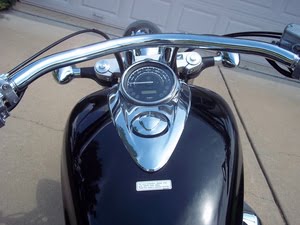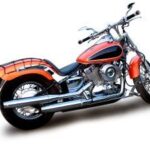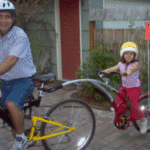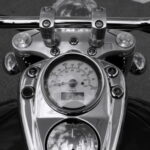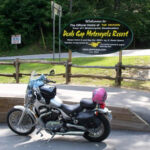The first time I saw the 2010 Honda Stateline motorcycle was in the showroom of a motorcycle dealership. I must not have been paying attention to the motorcycle news because here sat a beautiful bike that I knew absolutely nothing about. All three models in Honda’s new for 2010 1300 custom line are gorgeous to look at. There are only a few things different between the 2010 Honda Stateline I test drove and the 2010 Honda Sabre and 2010 Honda Interstate, so if you are looking at one of these, virtually everything in this review will hold true for those models as well. The salespeople who have talked about this bike call it an evolution from the VTX1300 and they are absolutely right. However, in evolving, the prices jumped up quite a bit and while the bikes are nice, there are better bikes available at this price point, albeit without Honda’s reputation for quality and longevity.
First Impressions of the 2010 Honda Stateline Motorcycle
The 2010 Honda Stateline is a low to the ground, stretched out bike. It has a 33 degree rake and is a full 70.1 inches long. The seat height is a short biker friendly 26.7 inches; however, the forward controls could negate some of the short biker friendliness. The engine is beautifully done and the chrome is tasteful but definitely there. The Sabre lacks a trim piece that hides all the wires and frame piece that, in my opinion, should be mandatory. The handlebars on the Honda Stateline are well designed and rounded and there is a classy looking single headlight. The fenders are both well done and in line with the entire look of the bike.
Sitting on the 2010 Honda Stateline
My 6’2″ frame fit comfortably on the Stateline, however, I did feel a bit like I was riding on the bike rather than sitting comfortably in it. The forward controls were comfortable and the shifter and brake were both set perfectly for easy access which is something that some bikes don’t have, including a 2010 Harley Dyna I sat on a few months back. The V-twin engine is offset to improve the balance and I took note of the big chrome cover on the rear cylinder, worried that it would end up conducting heat straight to my right leg. However, I never had a problem during riding.
Controls were basic as was the display that was well integrated into the gas tank. The controls include the tried and true turn signals, horn and high/low beam unit on the left and the starter on/off unit on the right. The front brake lever is non adjustable but well setup and the entire master cylinder was well chromed. The clutch on the Honda Stateline is of the cable variety so there is no matching cylinder on the left side of the bike. The large speedometer has a single turn signal indicator lamp as well as a high beam indicator lamp. There are also indicators for check engine, over temperature and low oil pressure and only a low fuel indicator. On a cruiser this is fine; however the 2010 Honda Interstate is billed as a touring model and has the same gauge cluster. A little gas light is not acceptable on a bike that I would be planning any type of long distance riding on.
Riding the 2010 Honda Stateline
Being over 90 degrees, I had no doubt the bike would start right up with no issues and I was right. One of the big upgrades for the Stateline over its predecessor, the VTX 1300, is that it is fuel injected. This means no playing with the choke and no grumpy starts on cooler days. It also should mean better power and better fuel economy. Honda claims 47 miles per gallon is possible and has absolutely no power ratings, horsepower or torque, on their site. However, after my drive, the power output is one of my biggest issues with this motorcycle.
Overall, the bike felt sluggish and underpowered, yet at the same time had an over active throttle. It was like they tried to make up for a lack of horsepower with a jumpy throttle to make it seem like it was chomping at the bit to go fast. Bumps and even weaving yielded changes in speed I have not seen, even from some of the sport bikes I have owned and ridden in the past. The acceleration was ok but not great but it always felt like the bike had to work. The engine is a blend of modern and old: it has a single pin crankshaft and a single overhead cam; yet it sports fuel injection, three valves per cylinder and two spark plugs per cylinder. The DOHC engine in the Victory Kingpin I test rode had a bigger engine and made more power and the bike, which weighed in the same, felt much more eager to accelerate. It is very likely that the shaft drive on the Honda Stateline ate up more power than the belt drive on the Victory as well and the Honda was still quite green, with only a few hundred miles on the Odometer. Still, it felt like it needed at least 10 more horsepower.
The braking on this bike was very good and easy to modulate. My test ride of a VTX1300 a couple years ago was cut short by abysmal braking performance from the front brake and I attributed it to the weight of the bike versus a single front brake with small pads and a lightweight caliper. The Honda Stateline I rode did not suffer from any issues and was absolutely fine in the braking department. It should be noted that there is a cross-linked ABS system available for all three of the Honda’s 1300 custom series bikes, for an additional thousand dollars.
I purposely took the bike out on my super secret test loop in Northwest Houston Texas. This loop has some good curves as well as a fairly bad road to test the suspension out. The bike handles admirably on the curves, only being limited by the low frame and forward controls which I scraped a couple times well before the handling limits of the rest of the bike were tested at all. It’s unfortunate because the bike definitely does enjoy being tossed around. I could only image what the damage would be after any of the rides listed in my scenic drives article, much less something like the Dragon.
The bike did not do well on the bad road I have as part of my loop. The rear suspension, being a hidden suspension, has very little travel and all of the bumps rattled me. To top it off, the front suspension did not fare much better. Honda, nor the salesperson, mentioned whether the rear suspension could be adjusted but with only 3.9 inches of travel, I’m not sure what all could really be done to improve it. Small bumps, such as highway expansion joints were a complete non-issue and were dealt with just fine. The larger bumps were a big issue, especially with the twitchy throttle response; making the up and down motion translate into a pretty serious acceleration/deceleration motion as well.
One thing I will give Honda credit for is that the bike sounded really good and from a sound perspective no improvement is really needed. Many manufacturers over muffle their stock pipes but the Honda Stateline does not suffer from this fate. The balance was perfect, I could hear the bike, others could hear the bike but they weren’t so loud as to cause fatigue or annoy anyone either.
The only other quibble I had with the bike was the radiator fan. It works and works very well, to the point where the bike, fully heated up, did not need the fan for most of a light cycle even on a sunny 93 degree day. I’m sure the fins on the engine are not just for show but the fan blows serious air and this is where the problem lies. Due to the frame design, that air blows past the front cylinder and right onto your arm, especially your right arm. Its summer, I’m hot already, I really don’t need more hot air being blown on me and this air is particularly warm. I wish I had a way to measure it but it was unpleasant at 93 degrees. Had it been a typical July day in Houston, pushing the high 90’s it would have possibly become truly uncomfortable.
Summary
The Honda Stateline is a good bike and is definitely a better bike than the one it replaced, the VTX1300. However, with a starting price of $11,699, it puts it higher than other bikes with similar sized engines and if you consider the power output a priority, you are looking at around an additional $2,000 to get the ten to fifteen horsepower it really needs to be able to keep up with a Harley Street Bob (msrp: $12,999) or Victory Kingpin (msrp: $12,999). You get Honda quality with the Stateline but Victory and Harley both offer better standard warranties. You also get an extra cruising gear with both of these bikes. Honda’s pricing is slightly lower but it so close that many people cross shopping will find a greater value in the air-cooled offerings from American companies as well as competitor bikes from Yamaha, Suzuki and Kawasaki as well. When Honda’s lineup represented the best bike and the best bang for the buck, as it did when the VTX 1300 and VTX 1800 came out, the pricing was justified. Now, it seems that Honda is playing catch up.
References:
2010 Stateline Overview, Honda Powersports
2011 Street Bob, Harley-Davidson USA
Kingpin 8 Ball Cruiser: V-Twin Cruiser Motorcycle by Victory, Polaris Industries
